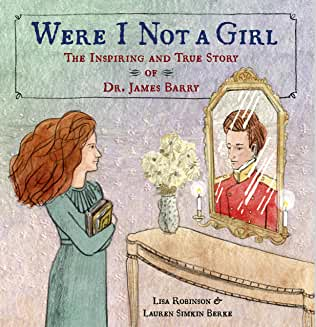
“We cannot define the interior life of James Barry. If Barry did identify as another gender—if he was a transgender man as it is understood today—he would not have had the language to say so. But we have his actions, and these reflect someone who lived as a man for nearly half a century and wished to be known as a man after his death. In this way, James Barry is a reminder that LGBTQ+ stories are often shrouded, confused, or misrepresented but have been, and will always be, an essential part of history.” – Mariel Tishma from “A surgeon and a gentleman: the life of James Barry”
Rob Sanders and Gayle E. Pitman have long dominated the LGBTQ+ nonfiction book market. By this I mean that Sanders and Pitman are responsible for the handful of biographies published since 2018. However, some recent publications are authored by newcomers to the field. One example is the 2020 biography, Were I Not a Girl: The Inspiring and True Story of Dr. James Barry, written by Lisa Robinson and illustrated by Lauren Simkin Berke.
The text opens with a request that readers reflect on what it would be like to live in the past. Robinson writes: “Imagine living at a time when you couldn’t be the person you felt you were inside. You couldn’t be your true self.” She continues: “This is a story about someone who refused to let that happen: Dr. James Barry.”
James Barry is a frequently discussed transgender historical figure who lived a fascinating life traveling the world as a renowned surgeon.
Although the book has a lot of potential, many of the choices Robinson made detract from the story as a transgender biography by suggesting James Barry’s gender identification and expression were motivated by a rejection of feminine gender roles, not a masculine gender identification. I don’t think this was intentional, but it could have and should have been avoided.
Robinson chooses to tell the story of Barry’s life in a linear narrative. She begins with his birth. In doing so, she deadnames him. She then details his early life, which he lived as a girl. Robinson suggests that young Barry had “big dreams,” but notes that girls had few options. Robinson returns to this point often.
When Barry was sixteen, his father abandoned the family. At that point, Barry and his mother traveled to England for more opportunities. In England, Barry took an interest in medicine, but, as Robinson notes, “women could not become doctors.”
After reemphasizing gender role constrains, Barry’s social transition is depicted, which implies that Barry is rejecting gender roles, not embracing transgender identity.
The majority of the text focuses on Barry’s early years. His many accomplishments are consolidated into a few short pages. After transitioning, a young James Barry is portrayed going to Scotland, enrolling in medical school, joining the military, and traveling the world. One image shows James Barry and a man embracing. The accompanying text explains that he fell in love, presumably with the man he is hugs.
If Robinson had focused the narrative on Barry’s illustrious career, avoided deadnaming, and chosen not to imply he was rejecting feminine gender roles instead of embracing a masculine identity, the book could have avoided problematic pitfalls. I don’t recommend this title for these reasons.
Learn more about James Barry:
https://www.sciencehistory.org/distillations/how-history-keeps-ignoring-james-barry
https://www.them.us/story/james-barry-ej-levy
A surgeon and a gentleman: the life of James Barry
Leave a comment